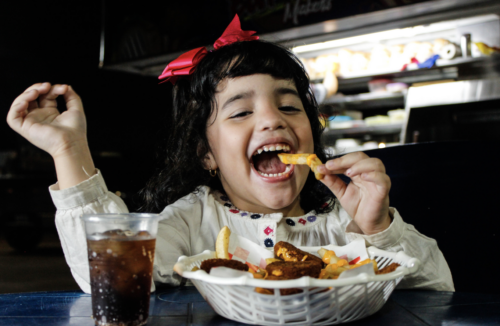Eating is one of the most basic daily functions that children engage in, and yet, it can be a source of great stress for parents. Parents often want their children to develop healthy eating patterns and make more desirable choices when it comes to food, but often times are unsure of the best ways to go about it. It can seem like despite best efforts, instilling healthy patterns of eating in kids can feel impossible. Below are some effective tips and strategies for helping kids develop a healthy relationship with food and establish healthy eating patterns to set them up for success.
Prompt your child to check in with and listen to their own levels of hunger and fullness during meals and snacks. From a young age, children have a great sense of their own internal hunger and fullness cues. While parents might feel tempted to encourage their child to finish all the food on their plate, doing so can inadvertently lead children to feel more disconnected from their own internal cues. This can ultimately contribute to children eating past the point of fullness or denying signs of hunger. As children get older, use of a hunger-fullness scale can help children continue to practice responding to their bodily cues.
Model your own healthy patterns in front of your children. Modeling is a very powerful tool in helping children learn behaviors. By eating at regular times throughout the day, being mindful of your own hunger and fullness cues, and eating a variety of different types of foods, children can learn through observing to establish the same types of behaviors. Verbally expressing some of these choices can help make these patterns most clear to children.
Expose your children to a variety of food options and reinforce flexibility and balance. By providing children with a variety of food options, they can learn to develop a taste for a greater number of foods. This also allows them to explore different food options and learn which foods they enjoy eating, which foods leave them feeling good, and which foods they want to continue eating. Parents also commonly want their children to eat the most nutritious food possible and stay away from foods deemed as “unhealthy” or “junk food.” However, restricting children’s access to certain foods while placing a high amount of pressure on other foods can have unforeseen impacts. Often, overcontrol and restriction of certain foods may lead children to overconsume those foods when they are made available to them. Additionally, labeling foods as “bad” or “good” can ultimately place a great amount of moral pressure on food choices and can result in a child struggling to listen to their own bodily cues. By reinforcing and modeling flexibility around more nutrient-dense foods and less nutrient-dense foods, children are better equipped to develop healthy relationships with food. Be flexible in how you present certain foods as well. For example, if your child is not liking crunchy things right now try cooking your veggies in a new way. You can change texture, flavor or visual appearance.
Provide children with social opportunities around food. Engaging in family meals regularly is a great way for children to experience the social rewards that food has to offer and can help them understand the link between healthy eating patterns and pleasure. By exposing children to social opportunities related to food, children learn that food serves an additional purpose outside of basic nutrition, in that it provides opportunities to connect with friends and family. This could also mean getting them involved in cooking. Cooking together with a focus on making it fun can be great bonding time as well as make food more enjoyable.
References:
Balantekin KN, Anzman-Frasca S,Francis LA, Ventura AK, Fisher JO, Johnson SL. (2020). Positive parenting approaches and their association with child eating and weight: A narrative review from infancy to adolescence. Pediatric Obesity, 1-15.
Birch, L., Savage, J. S., & Ventura, A. (2007). Influences on the Development of Children’s Eating Behaviours: From Infancy to Adolescence. Canadian journal of dietetic practice and research: A publication of Dietitians of Canada, 68(1), 1–56.
Savage, J. S., Fisher, J. O., & Birch, L. L. (2007). Parental influence on eating behavior: conception to adolescence. The Journal of law, medicine & ethics : A journal of the American Society of Law, Medicine & Ethics, 35(1), 22–34.








